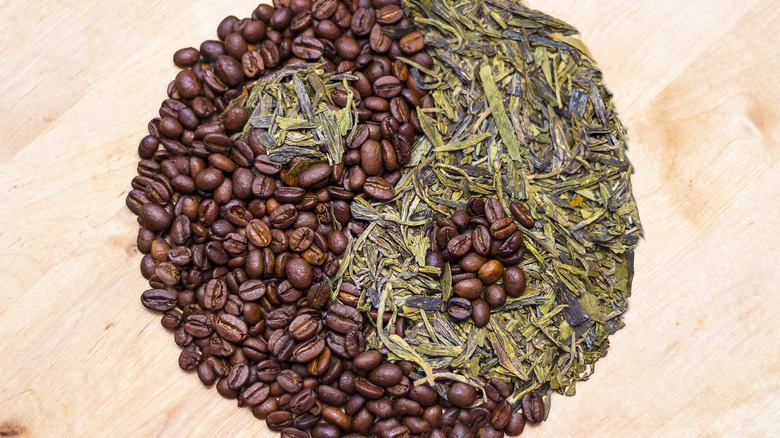Which Is Better For The Planet: Coffee Or Tea?
About 65% of Americans drink coffee every day, according to Coffee Rank. And nearly 80% of all American households have tea, per the Tea Association of the USA. Both coffee and tea have been linked to potential health benefits, nutritionist Keri Gans told Well+Good, as both beverages "are known to contain antioxidant-rich polyphenols with anti-inflammatory benefits." Both can also promote digestion, and the caffeine in each can help improve mental cognition.
People have even identified brewing and drinking coffee and/or tea as a hobby, and they dive deep into the minutiae of ingredients and preparation to make the perfect cup of coffee or mug of tea.
It could be easy to think of the choice between coffee and tea as just a personal preference, but is there one drink that's better for the planet than the other? As people think about sustainability and a healthy planet, we're perhaps most used to thinking about recycling or carbon emissions from vehicles. We may not think about it when it comes to our favorite morning beverage, though. Here are the considerations for tea vs coffee and the planet.
Tea edges out coffee for lower carbon footprint
According to BBC News' "Climate change food calculator," a cup of tea every day adds around 33 pounds to an individual's annual greenhouse gas emissions with coffee coming in at about 10 times. But it's more nuanced than just one or the other. You have to think about how you consume the drink and how it got to you.
One large factor of the carbon footprint of your coffee vs tea isn't actually the coffee or the tea — it's the milk. If you're adding cow milk to either drink, that increases the carbon footprint since cows produce methane (per The Guardian).
Both drinks also require boiling water. Coffee is generally made with a specific amount of water, but if you're heating water for your tea in a kettle, you're likely to heat more water than you'll actually use for that cup, which adds to the drink's carbon footprint
Considering how the coffee or tea was planted and harvested to help understand the carbon footprint. Not all coffees and teas are the same in terms their environmental impact. Here's what to be aware of.
More sustainable options are available for both coffee and tea
In Kenya, tea production areas use charcoal and firewood for processing, which leads to deforestation (per Borgen Project). Clearing land for tea production also results in deforestation, and the farms may use pesticides and insecticides for production (via Commodity Trading).
Another factor is that many tea bags are made with plastic, which can result in microplastics in the ecosystem, according to The Washington Post. Better for the planet tea options include loose leaf teas that are grown organically (per Conscious Lifestyle).
Traditionally, coffee plants have been grown under a canopy of shade trees as compared to sun-grown coffee (from The Exotic Bean). Growing coffee in the sun allows for more density and therefore more yield, but also causes deforestation; over 2.5 million acres of forest have been cleared in Central America to make room for sun-grown coffee (from Sustainable Business Toolkit). And sun-grown coffee also requires more pesticides and insecticides, per Sustainable Business Toolkit.
Clearing the forests for coffee also has a negative impact on the forest birds, and after a series of studies, the Smithsonian Migratory Bird Center determined that for migratory birds, shade-grown coffee "is the next best thing to a natural forest." Another bonus to shade-grown coffee is that it can help keep carbon out of the air, according to the Smithsonian Migratory Bird Center. So a more ecological approach to coffee would be to look for "Bird Friendly" coffee.


